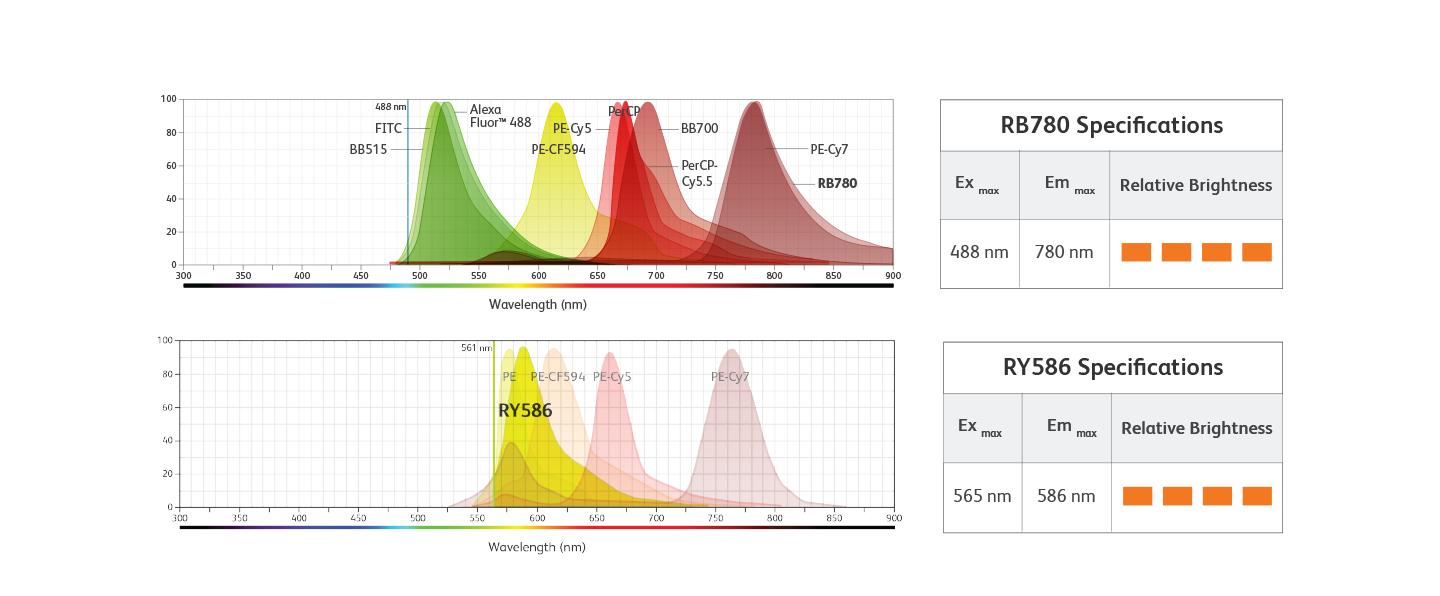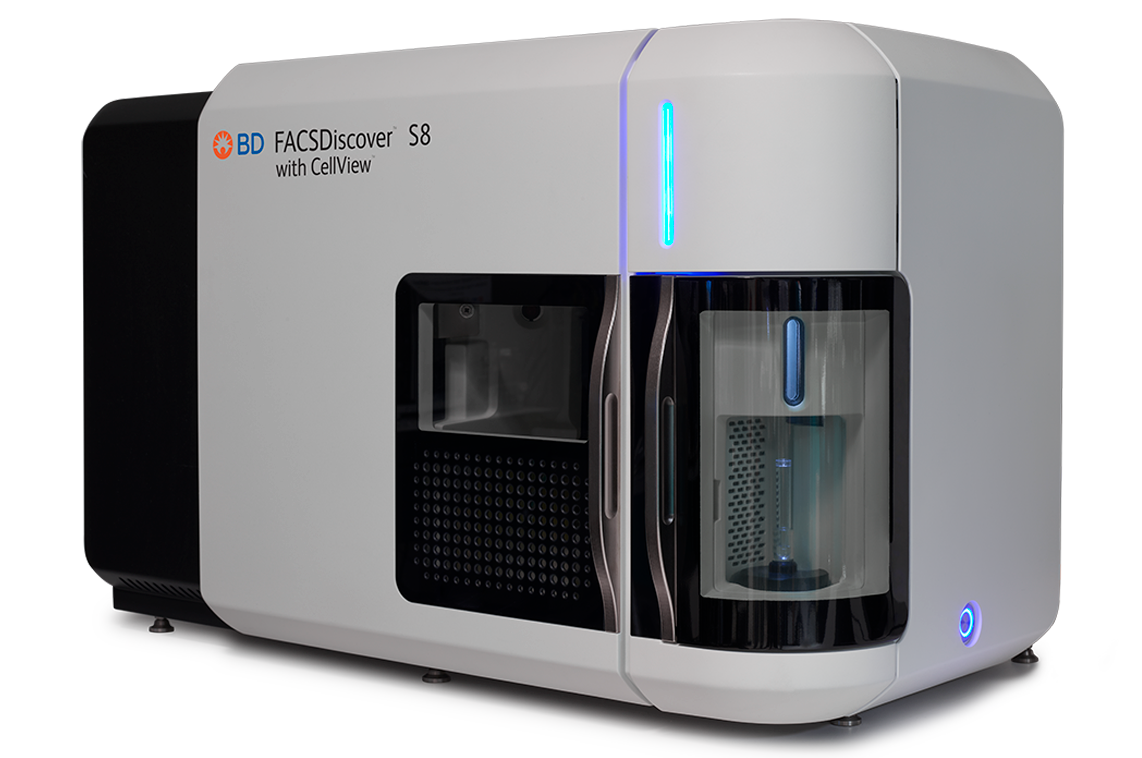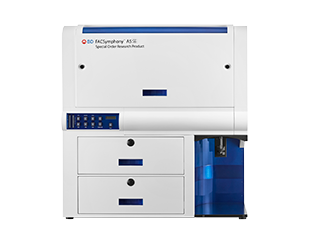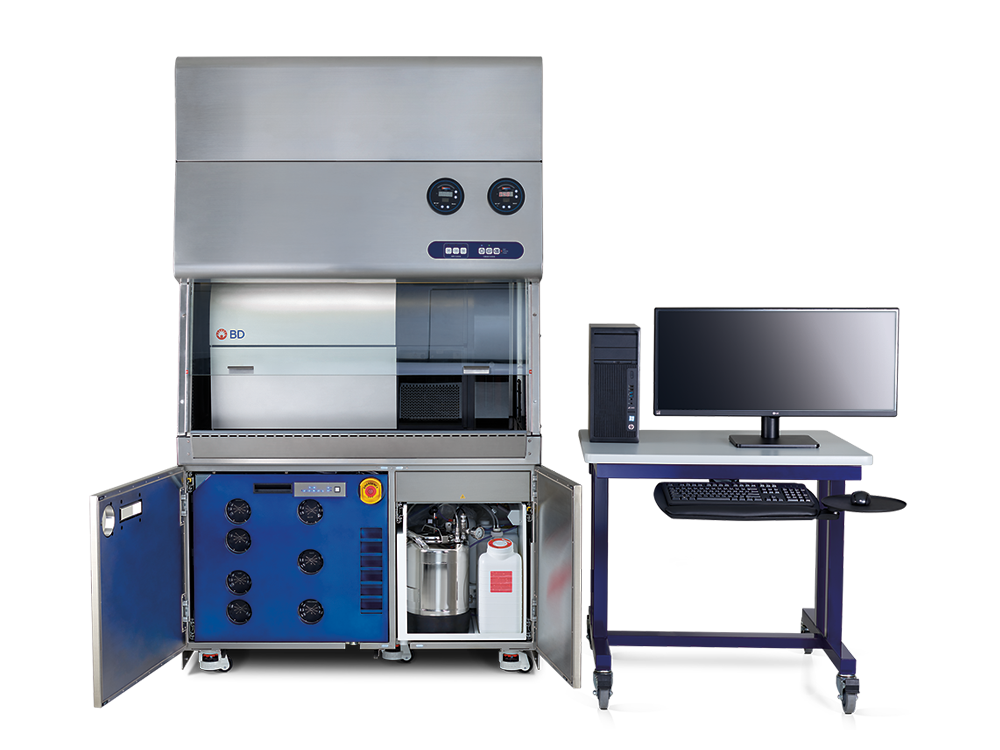-
抗体試薬
- フローサイトメトリー用試薬
-
ウェスタンブロッティング抗体試薬
- イムノアッセイ試薬
-
シングルセル試薬
- BD® OMICS-Guard Sample Preservation Buffer
- BD® OMICS-One Protein Panels
- BD® AbSeq Assay
- BD® Single-Cell Multiplexing Kit
- BD Rhapsody™ ATAC-Seq Assays
- BD Rhapsody™ Whole Transcriptome Analysis (WTA) Amplification Kit
- BD Rhapsody™ TCR/BCR Next Multiomic Assays
- BD Rhapsody™ Targeted mRNA Kits
- BD Rhapsody™ Accessory Kits
- BD® OMICS-One Immune Profiler Protein Panel
-
細胞機能評価のための試薬
-
顕微鏡・イメージング用試薬
-
細胞調製・分離試薬
Old Browser
Looks like you're visiting us from {countryName}.
Would you like to stay on the current location site or be switched to your location?

Spectral Flow Cytometry
Overview
フローサイトメトリーの機能は、利用可能なレーザー、検出器、および測定可能なパラメーターの数という点で、長年にわたって大幅に拡張されました。それに伴い、フローサイトメトリーに利用できる蛍光色素数は指数関数的に増加し、新たな発見の可能性が広がっています。従来のフローサイトメトリーは、蛍光色素ごとに単一の光学フィルターによって定義される蛍光スペクトルのみを測定しますが、スペクトルフローサイトメトリーは蛍光色素の全スペクトルを測定します。スペクトルフローサイトメトリーは自家蛍光の除去、レーザーラインあたりより多くの蛍光色素の検出、およびパネルサイズの拡張が可能になり、細胞測定の柔軟性が向上しています。スペクトルフローサイトメトリーが従来のフローサイトメトリーとどのように異なるのか、またスペクトルフローサイトメトリーのパネルデザインについてご覧ください。
スペクトルフローサイトメトリーがhigh-dimensional researchのための蛍光色素開発の状況をどのように変化させたかについて、ブログ記事をご覧ください。.
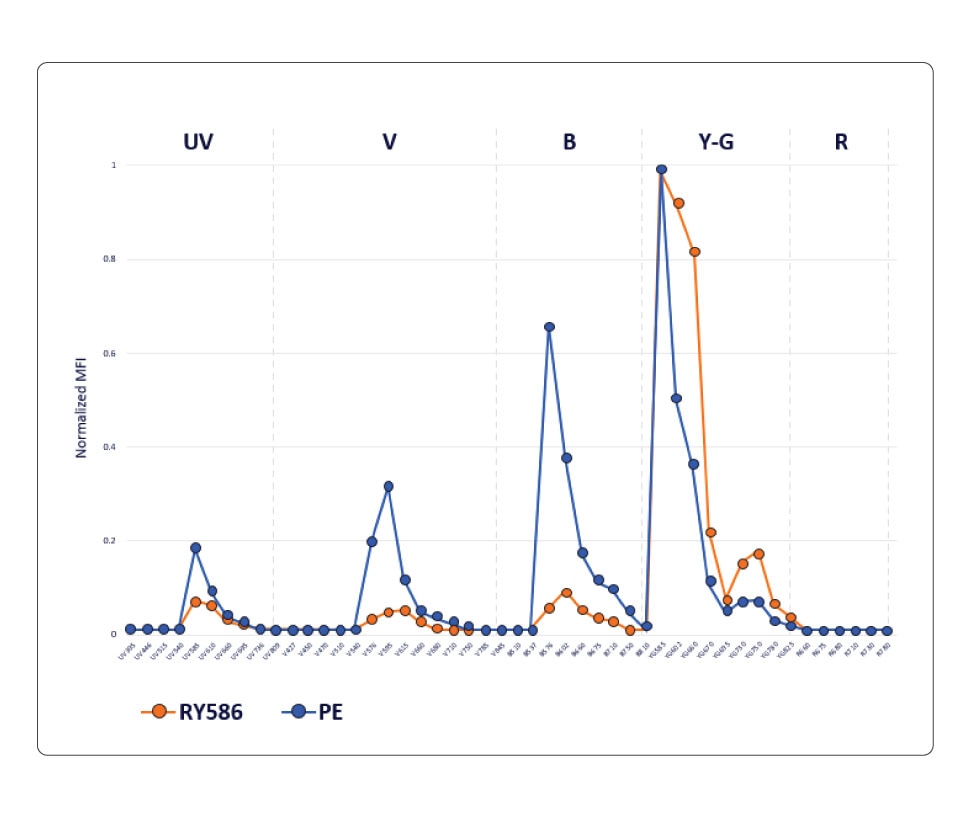
スペクトルと従来のフローサイトメトリーの比較
| 特徴 | スペクトルフローサイトメトリー | 従来のフローサイトメトリー |
| 検出器と蛍光色素の比率 | 蛍光色素よりも多くの検出器がある | 蛍光色素と同じ数の検出器がある |
| 個々の蛍光色素間の補正 | Unmixing | Compensation |
| 蛍光色素の選択 | 搭載レーザーのみに依存 | 搭載レーザーと光学フィルターの構成に依存 |
| 自家蛍光の除去 | Yes | No |
| 蛍光波長が近接した蛍光色素の分離 | Yes | No |
| マルチカラーパネル数 | 40+ colors | ~28 colors |
変わらない点
- ワークフロー (サンプル前処理、抗体染色、データ取得)
- Single stain controlが必要
- パネルデザインが必要
スペクトルフローサイトメトリーの概要
以下のビデオを視聴して、スペクトルフローサイトメトリーと従来のフローサイトメトリーの基礎、スペクトルフローサイトメトリーを使用してレーザーラインごとにより多くの蛍光色素を使用する方法、パネルサイズを拡張するためにスペクトルフローサイトメトリーを使用する方法など、さまざまなトピックをご検討ください。
スペクトルフローサイトメトリーと従来のフローサイトメトリーの基礎
このビデオでは次の内容を解説します:
- スペクトルフローサイトメトリーとは何ですか?
- 従来のフローサイトメトリーとスペクトルフローサイトメトリーの類似点と相違点は何ですか?
- スペクトルの特徴をどうやって読み取るのですか?
- スペクトルフローサイトメトリーの特徴は何ですか?
自家蛍光の除去
このビデオでは次の内容を解説します:
- 自家蛍光の除去とは何ですか?
- 自家蛍光はデータの分解能にどのような影響を与えるのでしょうか?
- 細胞固有の自家蛍光とは何ですか?
蛍光色素選択の柔軟性
このビデオでは次の内容を解説します:
- 従来のフローサイトメトリーまたはスペクトルフローサイトメトリーで蛍光色素を選択するにはどうすればよいですか?
- スペクトルフローサイトメトリーは、レーザーラインあたりにより多くの蛍光色素の使用をどのように可能にしますか?
- 蛍光タンパク質の検出にスペクトルフローサイトメトリーを使用する利点は何ですか?
パネルサイズの拡張
このビデオでは次の内容を解説します:
- スペクトルフローサイトメトリーは蛍光波長が近接した蛍光色素の分離をどのように可能にするのでしょうか?
- 蛍光波長が近接した蛍光色素を使用するための類似性指数とガイドラインは何ですか?
- 40色のマルチカラー スペクトルフローサイトメトリー パネルの背後にある詳細は何ですか?
マルチカラースペクトルフローサイトメトリーのパネルデザインのためのツールと考慮事項
スペクトルフローサイトメトリーは、フローサイトメトリーの能力、柔軟性を向上させた技術です。このウェビナーでは、従来のフローサイトメトリーとスペクトルフローサイトメトリーの基本的な類似点と相違点について取り上げ、マルチカラー スペクトルフローサイトメトリー パネルデザインの原理とツールを深く掘り下げます。
ウェビナーを見る
- スペクトルフローサイトメトリーとは何か、またそのユニークな点は何か
- 従来のフローサイトメトリーとスペクトルフローサイトメトリーに共通するパネルデザインの基本的なルールとツール
- スペクトルフローサイトメトリーに特有のパネルデザインの推奨事項と禁止事項
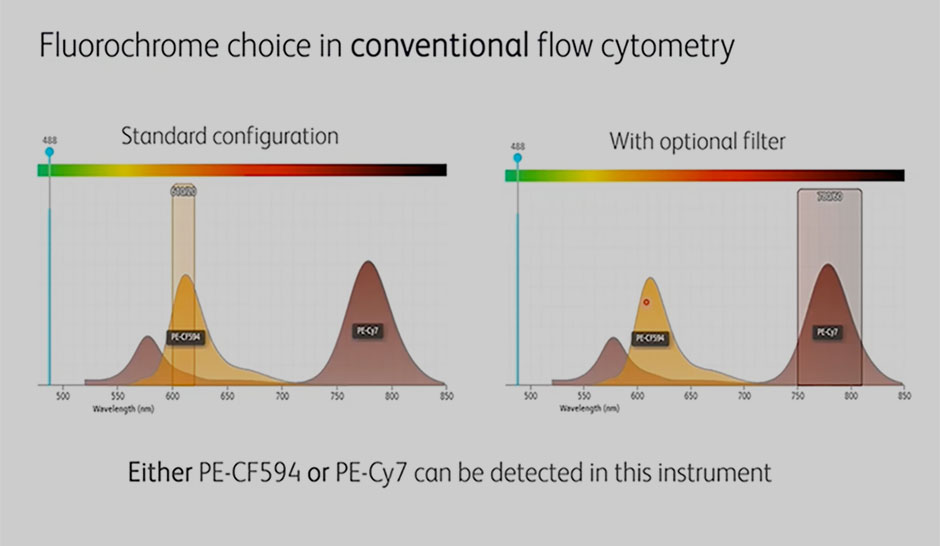
BD Horizon RealYellow™ および BD Horizon RealBlue™ 試薬
パネル内の各マーカーにどの蛍光色素を使用するかを把握し、より深い生物学的洞察につながる方法でそれらを割り当てることは、場合によっては困難な場合があります。
BD バイオサイエンスは、これらの選択に役立つ新しいパネルデザインリソースと、柔軟で簡単なパネルデザインのための幅広い抗体特異性および蛍光色素を提供します。
また、最適化された発光スペクトルとクロスレーザー励起の低減を備えたBD Horizon RealYellow™試薬 および BD Horizon RealBlue™ 試薬ファミリーなどの新しい試薬の開発も行っています。
これにより、信頼性の高い結果を効率的に導くことを目的としています。
BD バイオサイエンスは、従来のフローサイトメトリーとスペクトルフローサイトメトリーの両方をサポートするアナライザーとセルソーターを提供しています
スペクトルフローサイトメトリーは、従来のフローサイトメトリーに代わる革新的なツールであり、フィルターを変更することなく蛍光標識を検出できる柔軟性が得られるという利点と、1つのマルチカラーサンプルでより多くの蛍光標識を使用できるという利点があります。
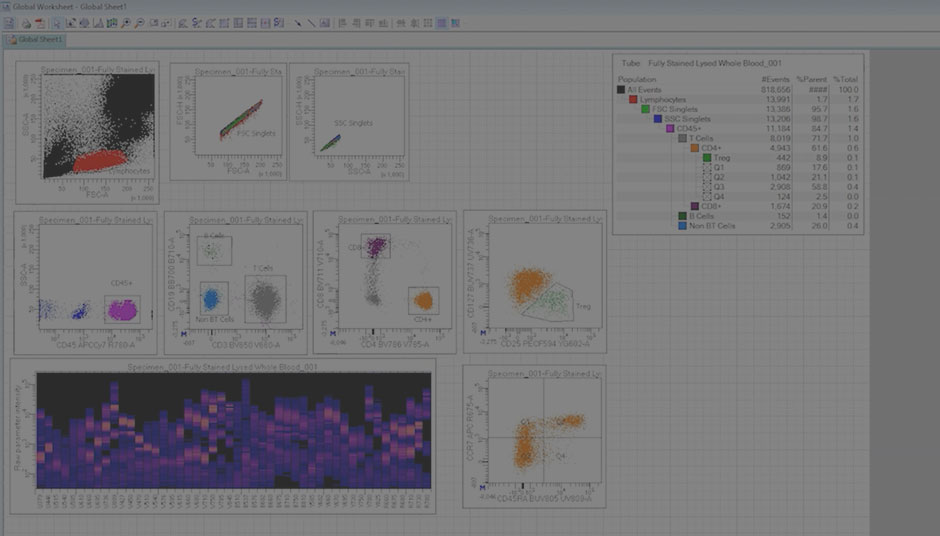
実験能力を高める
BD FACSymphony™ A5 SE セルアナライザーで作成されたこの40色のパネルは、パネルデザインされた蛍光試薬抗体を使用して、ヒト末梢血中のさまざまな免疫細胞集団を特徴付けます。
詳細については、BD FACSymphony™ A5 SE セルアナライザーのパンフレットをご覧ください。
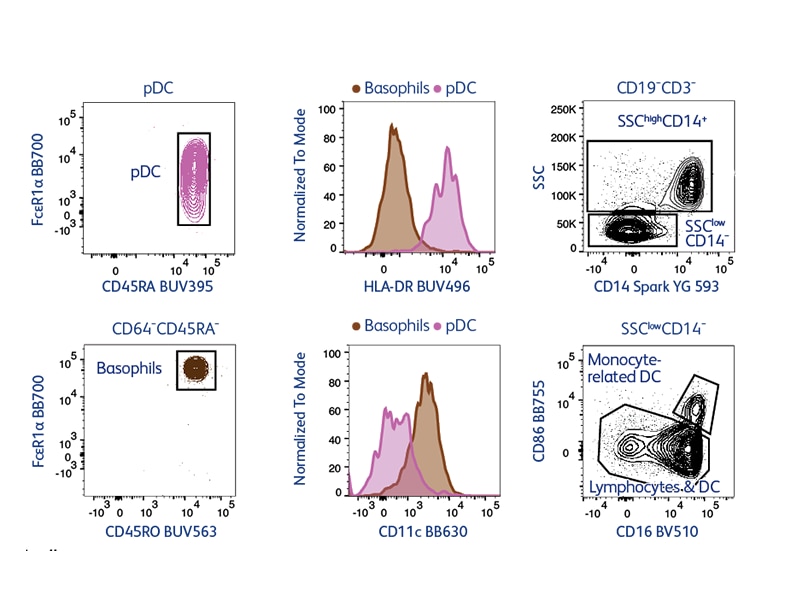
BD CellView™ Image TechnologyとBD SpectralFX™ Technologyを搭載した BD FACSDiscover™ S8 セル ソーターは、画像解析機能を搭載した初のスペクトルソーターです。スペクトルフローサイトメトリーとリアルタイムでの細胞の空間的また形態的情報を組み合わせることにより、細胞の解析とソーティングの技術は新たな次元を迎えました。
BD FACSymphony™ A5 SE セルアナライザーは、5本のレーザーと50種類のパラメーターを備えており、蛍光色素が発するスペクトルを最大限に検出します。
BD FACSymphony™ A5 SE セルアナライザーは、スペクトル測定と従来の蛍光補正ベース測定のワークフローの両方を使用する事が可能で、蛍光色素の選択における柔軟性を高め、同様のスペクトルシグネチャーを持つ蛍光色素の同時分析を可能にします。スペクトル測定は、自家蛍光の除去を使用して重要な細胞集団を検出することもできます。
BD FACSymphony™ S6 セルソーターは、BD FACSymphony™ A5 セルアナライザーとBD FACSAria™ Fusionセルソーターという確立された基盤を元に開発され、フローサイトメトリーの最先端技術に対応したソーティングを可能にする製品です。
BD FACSymphony™ S6 セルソーターは、5本のレーザーで最大50種類のパラメーターを使用し、極めて特異的な細胞集団を特定し、ソーティングすることが可能です。また、細胞集団を6wayソーティングまたはプレートソーティング機能により柔軟に分取する事が可能です。
BD FACSymphony™ S6 セルソーターは、バイオインフォマティクス分析ツールおよびBD ハイパラメーター試薬の幅広いポートフォリオと併せて、ハイパラメーター実験を成功させるためのエンドツーエンドのソリューションを提供します。
Videos
Spectral flow cytometry increases the flexibility and capability of flow cytometry experiments. In contrast to conventional flow cytometry that is limited by the number of detectors and filters for collecting the emission spectrum, spectral flow cytometry has no such limitation and is able to collect the entire spectrum. This enables autofluorescence profiling and extraction, detection of more fluorochromes per laser line and increased panel size, increasing flexibility. Watch our spectral videos presented below that provide an in-depth explanation on these capabilities.
Do you want to transition from conventional to spectral flow cytometry? Or maybe you’re already doing spectral flow cytometry and want to improve the quality of your data? Gain a deeper understanding of spectral flow cytometry by going back to the fundamentals. Join Peter Mage for an engineer’s perspective on the science of spectral flow cytometry as he explains how the concepts at the heart of spectral technology can inform your experiment design.
In this webinar, he’ll discuss:
- The relationship between conventional and spectral flow cytometry technology
- The difference between conventional compensation and spectral unmixing
- How to build an intuitive mental model for spectral flow cytometry that can help you understand your experiments and data in a new light
High-dimensional immunoprofiling is essential for studying host response to immunotherapy, infection and disease in murine model systems. However, the difficulty of multiparameter panel design combined with a lack of existing murine tools has prevented the comprehensive study of all major leukocyte phenotypes in a single assay.
To fill this niche, we present a 40-color flow cytometry panel for deep immunophenotyping in primary and secondary lymphoid tissues. Importantly, the panel solely relies on extracellular staining to preserve cells for downstream experiments and can identify functional lymphocyte and myeloid subsets. In this webinar, we will discuss how the panel was engineered, as well as special considerations in reagent optimization, spectral unmixing, autofluorescence extraction and multi-dimensional analysis.
Real-time image feature extraction enables novel avenues of research and sort possibilities as we can classify and characterize cell populations based on spatial distribution of fluorescence. The possibilities broaden further when these imaging capabilities are coupled with next-generation spectral immunophenotyping. Although spectral cytometry can seem intimidating or complex, our advanced spectral cytometry system, BD FACSDiscover™ S8 Cell Sorter with BD CellView™ Image Technology and BD SpectralFX™ Technology, combines full-spectrum optics and optimized hardware design with a system-aware algorithm, next-generation quality control (QC) and guided software workflow so users can get started quickly.
In this webinar, Aaron Middlebrook, Sr. Staff Scientist, R&D, BD, and Peter Mage, Associate Principal Engineer, Advanced Technology Group, BD, will demonstrate the power of real-time imaging, spectral flow cytometry (RTI-SFC) and share best practices in experimental setup and examples of applications using this novel technology.
Learn about:
- Panel considerations for RTI-SFC
- Benefits and limitations of combining spectral immunophenotyping with imaging
- Maximizing data yield through computational analyses
Spectral flow cytometry is an established technology that has increased the power, flexibility and complexity of flow cytometry. This webinar addresses the fundamental similarities and differences between conventional and spectral flow cytometry and dives deeper into facts and misconceptions around the principles and tools for multicolor spectral flow cytometry panel design.
Topics:
- What is spectral flow cytometry and what makes it unique
- Fundamental rules and tools for panel design common to conventional and spectral flow cytometry
- The do’s and don’ts of panel design specific to spectral flow cytometry
Flow cytometry is a powerful technique for the analysis and isolation of cells based on their physical and biochemical properties. As the complexity and diversity of biological systems are increasingly revealed, there is a growing need for high-parameter cell analysis to characterize the heterogeneity and assess functionality of specific cell populations.
In recent years, spectral flow cytometry has emerged as a powerful technology that enables higher-dimensional cell analysis and sorting by capturing the full emission spectra of each fluorophore. This newer approach has pushed the boundaries for improved fluorescent dyes that can be used together without compromising biology as panels get larger and thus contributes to advancing research in various fields, such as immunology, cell biology, cancer, stem cells, and microbiology.
This webcast will review the principles and concepts of spectral flow cytometry, describe current technology innovations, and showcase some of the exciting discoveries made possible by spectral flow cytometry, while also discussing practical tips and best practices for researchers who want to adopt this technology.
For Research Use Only. Not for use in diagnostic or therapeutic procedures.
Alexa Fluor (AF) is a trademark of Thermo Fisher Scientific. Cy is a trademark of Global Life Sciences Germany GmbH or an affiliate doing business as Cytiva.
